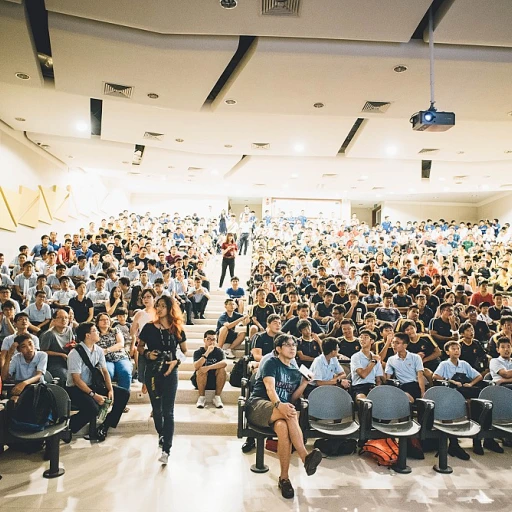
Understanding Conversational AI Chatbots
Transforming Employee Interaction with Virtual Tools
The emergence of conversational AI chatbots has revolutionized the way businesses manage employee interactions. These virtual assistants provide round-the-clock support, offering businesses a scalable solution to enhance employee experience. Leveraging natural language processing and machine learning, chatbot conversational solutions can efficiently handle a variety of tasks, from answering frequently asked questions to assisting with customer service operations. A distinct advantage of using conversational chatbots is their ability to process vast amounts of data in real time. This ensures immediate responses to employee queries and streamlines the decision-making process for complex tasks. Moreover, these chatbots conversational systems can continuously learn and adapt from each interaction, providing improved support and personalized user experiences over time. That said, these tools aren't without their challenges. For instance, while rule based chatbots can handle structured queries efficiently, they may falter when faced with nuanced human language. Additionally, while AI chatbots excel at handling routine tasks, they often lack the empathy and emotional understanding that human assistants bring to the table. The integration of conversational AI in enhancing employee engagement is an area that continues to evolve. Businesses have the opportunity to blend the capabilities of chatbot virtual assistants with the interpersonal strengths of human agents. To learn more about how HR practices are adapting to these innovative solutions, consider exploring engaging lunch and learn strategies for HR transformation.The Role of Human Assistants in Employee Experience
Emphasizing the Significance of Human Interaction
In the evolving landscape of employee experience, human assistants hold a cornerstone role that cannot be overlooked. Despite the surge of conversational AI and chatbots providing timely, rule-based services, the presence of human interaction is indispensable. Maintaining this equilibrium ensures that employees feel valued and understood on a personal level. Human assistants are equipped with the unique ability to perceive nuances and adapt in real time, which stands in contrast to the limitations of chatbots. They leverage emotional intelligence to navigate complex interactions, allowing for more empathetic and individualized support. This personal touch fosters a deeper connection, which is pivotal in enhancing the overall employee journey.Bridging Gaps in Technology and Emotion
Even as conversational chatbots become more sophisticated, they cannot entirely replace the human element in decision-making and emotional cognition. Virtual assistants may excel in managing routine tasks through natural language processing and machine learning. Still, it is human agents who excel in tailoring solutions during critical and sensitive situations where business outcomes and employee morale are at stake. Human assistants provide invaluable insights, drawing from a wealth of personal experiences that are essential for improved employee engagement. The need for human support becomes especially evident when navigating complex issues that require tact and understanding beyond what AI can offer. Furthermore, human experience adds authenticity and trust, which are quintessential for a supportive culture in the workplace. When organizations implement both human and virtual assistive solutions, employees benefit from a comprehensive support system that accommodates various needs efficiently. For further exploration on how options can expand resources, see how HR should embrace more online resources. This balance between technology and human interaction ensures that businesses cultivate an environment where employees feel supported and engaged, ultimately contributing to sustained satisfaction and loyalty.Comparative Analysis: Chatbots vs. Human Assistants
Pros and Cons: Weighing the Benefits of Chatbots and Human Assistants
When enhancing employee experience through conversational tools, the choice between AI-driven chatbots and human assistants has become pivotal. Conversational AI chatbots, powered by artificial intelligence and natural language processing, have revolutionized how businesses provide support and handle routine tasks. They are capable of processing vast amounts of data in real time, offering immediate responses and solutions.
On the other hand, human assistants shine in complex situations that require emotional intelligence and nuanced decision making. Their ability to comprehend complex human emotions and adapt to varying scenarios is unmatched by rule based chatbot solutions.
Let's delve deeper into the comparative analysis of these two distinct support systems:
- Efficiency and Speed: Conversational chatbots facilitate quick responses, handling numerous queries simultaneously. They reduce wait times and streamline customer service, enhancing the overall employee experience with consistent support. Meanwhile, human assistants might not match the speed of virtual assistants but provide a personalized touch that can often lead to better employee engagement.
- Consistency and Availability: Chatbots are available 24/7, offering consistent service without fatigue – an unparalleled advantage for companies operating globally. Human assistants, constrained by working hours and personal limitations, can offer more varied support that adjusts based on the user's needs and the complexities involved.
- Complex Problem Solving: While chatbots excel in processing data and executing predefined tasks, human assistants are invaluable for scenarios that require empathy and intricate decision making. Employees often benefit from the insights and flexibility offered by human agents in such situations.
As businesses aim to enhance employee engagement and satisfaction, understanding the distinct roles of conversational chatbots and human assistants becomes vital. Striking a balance between these two can lead to an empowered workforce, ultimately transforming the overall employee experience. To further explore how strategic choices can enhance recruitment and employee satisfaction, you may wish to read more about employer branding strategies.
Impact on Employee Engagement and Satisfaction
The Influence on Engagement and Satisfaction
In our digital age, enhancing employee engagement and satisfaction has become paramount. It's important to understand how both conversational chatbots and human assistants can contribute to this goal.
Chatbots and virtual assistants provide real-time support for employees, addressing queries swiftly. The use of advanced artificial intelligence, such as natural language processing, allows these tools to comprehend and respond to employee issues efficiently. This immediate support can greatly enhance user experience, leading to higher levels of satisfaction.
On the other hand, human assistants offer a personal touch that technology often lacks. Their capacity for empathy and nuanced communication fosters a deeper connection with employees, fulfilling emotional needs that virtual assistants may not address. This personalized interaction can significantly boost employee engagement by making employees feel valued and understood.
Comparative Benefits
The integration of AI in the form of chatbots aids businesses in completing repetitive and rule based tasks without human intervention. This frees up human resources to focus on decision-making activities that require a higher level of human judgement. Meanwhile, human assistants can cater to complex tasks that necessitate emotional intelligence and adaptive thinking, providing a balanced support system alongside chatbots.
- Chatbots: Excel in real-time customer and employee support. Efficient in handling repetitive inquiries, enriching the overall chatbot conversational experience.
- Human Assistants: Superior in interactive tasks that demand human empathy, offering personalized service and strengthening the employee connection.
Tangible Impacts
Both chatbots and human assistants have distinct yet complementary roles in crafting a satisfying employee experience. By automating mundane tasks, chatbots allow human agents to engage deeply with users on more complex issues. Conversely, the presence of human assistants is essential in situations where technology falls short—particularly in the realms of empathy and nuanced communication.
The combined application of these technologies and human resources promotes a holistic conversational support environment, paving the way for a more engaged workforce and a conducive work atmosphere. While challenges remain in implementing AI solutions effectively, the advantages they bring to employee engagement and satisfaction are undeniable.
Challenges in Implementing AI Chatbots
Overcoming Challenges in Deploying AI-Powered Chatbots
The adoption of conversational AI chatbots in enhancing employee experience is not without its hurdles. While virtual assistants offer promising benefits like efficiency and scalability, organizations must address several challenges to fully harness these tools.- Data Security and Privacy: With AI chatbots handling sensitive data, ensuring robust security measures is crucial. Businesses must invest in advanced encryption technologies and adhere to privacy regulations to prevent data breaches and protect employee information.
- Integration with Existing Systems: Integrating chatbots with existing business processes and tools can be a complex task. Successful integration requires thorough planning to ensure seamless workflow and to leverage existing customer support systems effectively.
- Natural Language Processing Limitations: Despite advances in machine learning, natural language processing (NLP) still faces challenges in understanding user inputs accurately. Organizations need to refine their chatbots continuously, improving language processing capabilities to enhance the overall user experience.
- Balancing Efficiency and Personalization: While chatbots can automate routine tasks efficiently, maintaining the personalization of human assistants in customer service remains challenging. To improve employee engagement, businesses must find a balance between automation and personal interaction.
- User Adoption: For chatbots to be effective, employees must adopt and adapt to these conversational solutions. Organizations should invest in training sessions and real-time support to address concerns and enhance employees' comfort levels with leveraging AI tools.
Future Trends in Employee Experience Enhancement
Looking Ahead: Shaping the Future of Employee Interaction
The landscape of employee interaction is being rapidly transformed through technological advances, especially with the integration of conversational AI chatbots and human assistants. As businesses strive for a superior employee experience, the move towards hybrid models combining these technologies is anticipated. Chatbots have ushered in a new era of interaction, leveraging artificial intelligence, machine learning, and natural language processing to facilitate real-time support and streamline tasks. These virtual assistants are progressively being used to handle routine inquiries, leaving human agents to focus on more complex needs. In the realm of employee engagement, conversational solutions based on both chatbots and human assistants are expected to further harmonize. As user expectations evolve, so will the tools that cater to them. To navigate this transformation, businesses must pay attention to several key trends:- Enhanced Personalization: Companies will increasingly use data-driven insights to tailor experiences more closely to individual employee needs and preferences.
- Integration of Contextual Understanding: Future conversational chatbots will be more adept at understanding context, which will elevate the virtual assistant interactions to be more intuitive and empathetic.
- Blending of AI with Human Touch: To achieve a balanced experience, businesses will deploy chatbots alongside human assistants, ensuring that technology enhances rather than replaces human interaction.
- Focus on Real-Time Solutions: As demand for immediate and effective support grows, the integration of AI chatbots in providing real-time assistance will be paramount for efficient business functioning.












